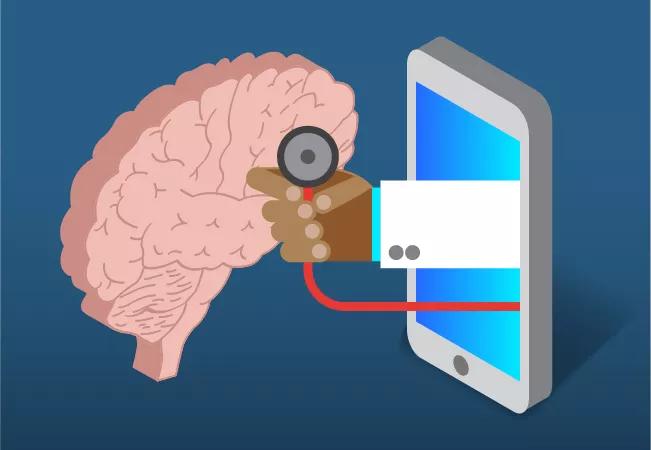Findings support a role for teleneurology in MS management

Teleneurology is an effective surrogate for many aspects of in-person multiple sclerosis (MS) care and deserves to be more thoroughly explored to establish its full role. So conclude the authors of a Cleveland Clinic study presented at the recent 2021 digital congress of ECTRIMS (European Committee for Treatment and Research in Multiple Sclerosis).
Advertisement
Cleveland Clinic is a non-profit academic medical center. Advertising on our site helps support our mission. We do not endorse non-Cleveland Clinic products or services. Policy
The longitudinal study showed that patients with MS whose care included teleneurology visits had clinical outcomes indistinguishable from those of patients who received exclusively in-person care.
“We’ve had a teleneurology infrastructure in place at Cleveland Clinic since late 2014, and we started to use it more frequently at the Mellen Center for Multiple Sclerosis in 2018,” notes lead investigator Marisa McGinley, DO, a neurologist with the Mellen Center. Still, only about 3% of the center’s patients used teleneurology before the COVID-19 pandemic, due largely to insurance-related barriers to access for many patients. Those who used virtual visits pre-pandemic generally lived a long distance from Cleveland Clinic facilities and thus avoided travel and lodging costs through teleneurology.
When COVID-19 prompted an eight-week shelter-in-place order for Ohio starting in March 2020, those access barriers were lifted. “We started using teleneurology more consistently, which meant there were a lot more virtual visits in our system, and it was time to take a look at how integrating them into MS care was affecting clinical outcomes,” Dr. McGinley explains.
The study evaluated outcomes among all patients with MS who completed at least two in-person visits (six to 18 months apart) during the study period, which spanned January 2019 to December 2020. Of the 2,131 qualifying patients, 89.4% (n = 1,905) had only in-person visits while 10.6% (n = 226) had teleneurology visits plus in-person visits. The study used multiple linear regression models to compare clinical outcomes between the patients managed exclusively with in-person visits and those managed with both virtual and in-person visits.
Advertisement
Study participants had a mean (± SD) age of 49.5 ± 12.6 years and mean disease duration of 15.9 ± 11.5 years. The cohort was 72.4% female, 81.4% white and 55.3% employed.
The two study groups (in-person only vs. teleneurology) were statistically similar in age, sex, race, employment status and education as well as in baseline performance on the three clinical measures assessed: processing speed, manual dexterity and walking speed. The two groups differed significantly on the following factors:
Additionally, the median total number of visits was significantly higher in the teleneurology group (4) than in the in-person only group (3). “We had to be cautious when bringing patients into the facility, as we were trying to balance minimizing exposure to infectious risks against maintaining MS treatment,” Dr. McGinley explains.
On the study’s primary outcome measures — mean change in performance on the processing speed test, manual dexterity test and walking speed test — there were no significant differences between the in-person only group and the teleneurology group after controlling for covariates.
“This finding of similar outcomes in disease progression regardless of patients’ mix of visit types was reassuring,” Dr. McGinley says.
Advertisement
The role of virtual visits is definitely expanding in MS, although Dr. McGinley notes that the need for infusion treatments and periodic MRIs and lab work to assess disease status means 100% teleneurology is not an option at this time.
“The main consideration we had to weigh was whether to delay bringing patients into the office for MRIs by a few months, if they were doing well,” she explains. “But we didn’t avoid providing in-person care if patients were showing symptoms because we knew that could risk increased disease activity and accrual of disability. It’s encouraging to see that patients now have the potential for better access to their care team through a combination of virtual and in-person visits. Better access may translate to improved outcomes over the long run.”
The benefits seen in the study point to increased use of virtual visits in the future, Dr. McGinley adds. “Notably, before the pandemic, many of our teleneurology patients lived further from our center, whereas we now see that our teleneurology population more closely reflects our typical clinic population,” she observes. “This suggests that teleneurology for MS care is definitely here to stay. What we now need to do is better understand the dosing — what is the optimal frequency of in-person versus teleneurology visits?”
That, she says, will be a focus of future studies, along with the quality of teleneurology care delivery and how best to virtually assess patients’ disease status in an objective manner.
Advertisement
Advertisement

Digital “tripwires” detect and respond to malicious activity, boosting cybersecurity maturity

Effective provider training strategies incorporate multi-modal delivery

Thoughtful collaboration, data-driven decisions and effective change management lead to significant savings

A thoughtfully designed program to elevate participants’ leadership potential

Clinical input is integral to technology implementation and adoption strategy

Advancing technology makes informatics expertise essential

Integrating technology is more than product delivery

Combined expertise, collaboration and technology lead to several improvements